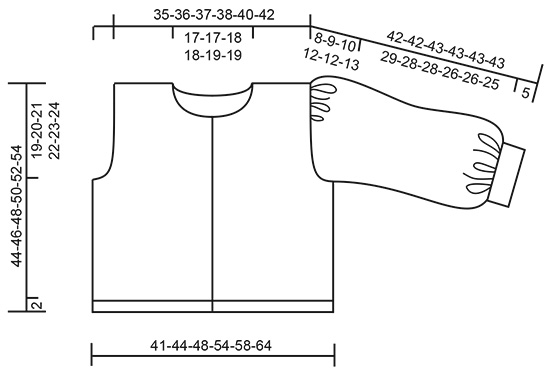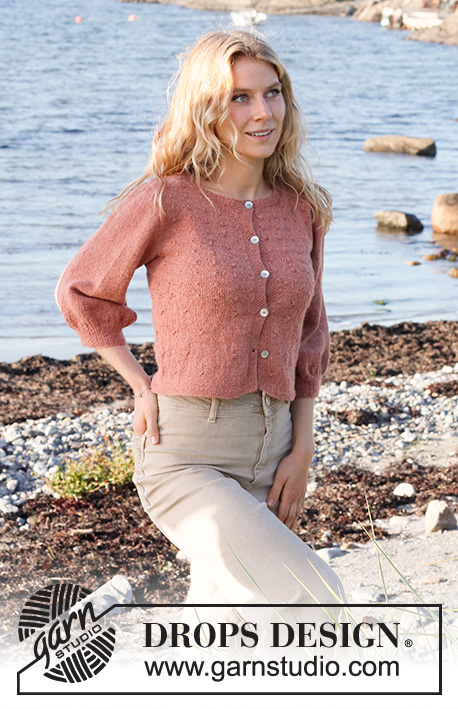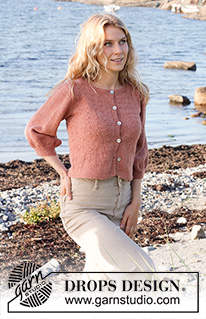Copper Harbor |
|||||||
 |
 |
||||||
Knitted jacket in DROPS Alpaca. The piece is worked with knotted pattern and ¾-length, balloon sleeves. Sizes S - XXXL.
DROPS 221-38 |
|||||||
|
------------------------------------------------------- EXPLANATIONS FOR THE PATTERN: ------------------------------------------------------- MOSS STITCH: ROW/ROUND 1: * Knit 1, purl 1 *, work from *-*. ROW/ROUND 2: Knit over purl and purl over knit. Repeat row/round 2 onwards. PATTERN: See diagrams A.1 and A.2. The diagrams show all rows in the pattern from the right side. DECREASE TIP (for sleeves): Decrease 1 stitch on either side of the marker thread as follows: Work until there are 3 stitches left before the marker thread, knit 2 together, knit 2 (marker thread sits between these 2 stitches), slip 1 stitch as if to knit, knit 1 and pass the slipped stitch over the knitted stitch (2 stitches decreased). INCREASE TIP (evenly spaced): To work out how to increase evenly, count the total number of stitches on the needle (e.g. 80 stitches) and divide by the number of increases to be made (e.g. 16) = 5. In this example, increase by making 1 yarn over after each 5th stitch. On the next round knit the yarn overs twisted to avoid holes. BUTTONHOLES: Work buttonholes on right band, from the right side. 1 BUTTONHOLE = knit together the third and fourth stitch from the edge and make 1 yarn over. On the next row (wrong side) knit the yarn over to leave a hole. Work the buttonholes when the piece measures: S: 8, 15, 22 and 29 cm = 3⅛", 6", 8¾" and 11⅜" M: 6, 14, 22 and 30 cm = 2⅜", 5½", 8¾" and 11¾" L: 7, 15, 23 and 31 cm = 2¾", 6", 9" and 12¼" XL: 6, 13, 20, 27 and 34 cm = 2⅜", 5⅛", 8", 10⅝" and 13⅜" XXL: 7, 14, 21, 28 and 35 cm = 2¾", 5½", 8¼", 11" and 13¾" XXXL: 9, 16, 23, 30 and 37 cm = 3½", 6¼", 9", 11¾" and 14½" NOTE: The last buttonhole is not mentioned here, as it is described in the text. ------------------------------------------------------- START THE PIECE HERE: ------------------------------------------------------- JACKET – SHORT OVERVIEW OF THE PIECE: The body is worked back and forth with circular needle, as far as the armholes. Then the front and back pieces are finished separately. The sleeves are worked in the round with short circular needle/double pointed needles as far as the armholes, then the sleeve caps are finished back and forth. The shoulder seams are sewn together and the sleeves sewn in. The neck is worked to finish. BODY: Cast on 211-227-243-275-291-323 stitches (including 7 band stitches on each side towards mid-front) with circular needle size 2.5 MM = US 1.5 and Alpaca. Work MOSS STITCH back and forth for 2 cm = ¾" – read description above, and finish after a row from the wrong side. Change to circular needle size 3 MM = US 2.5. Work 2 rows of stockinette stitch, with 7 band stitches in moss stitch on each side. The next row is worked as follows from the right side: 7 band stitches in moss stitch, work A.1A (= 12 stitches), A.1B until there are 16 stitches left (= 11-12-13-15-16-18 repeats of 16 stitches), A.1C (= 9 stitches) and finish with 7 band stitches in moss stitch. Continue this pattern back and forth. REMEMBER THE KNITTING GAUGE and remember the BUTTONHOLES on the right band – read description above! When A.1 has been worked 2 times in height, the piece measures approx. 20 cm = 8". The next row is worked as follows from the right side: 7 band stitches in moss stitch, work A.2A (= 4 stitches), A.2B until there are 16 stitches left (= 23-25-27-31-33-37 repeats of 8 stitches), A.2C (= 9 stitches) and finish with 7 band stitches in moss stitch. Continue this pattern – A.2 is repeated in height to finished length. AT THE SAME TIME when the piece measures 25-26-27-28-29-30 cm = 9¾"-10¼"-10⅝"-11"-11⅜"-11¾", bind off for the armholes on the next row from the wrong side as follows: Work 53-57-61-69-73-81 stitches as before (= left front piece), bind off 6 stitches, work 93-101-109-125-133-149 stitches as before (= back piece), bind off 6 stitches and work the last 53-57-61-69-73-81 stitches as before (= right front piece). Front and back pieces are finished separately. RIGHT FRONT PIECE (when the garment is worn): = 53-57-61-69-73-81 stitches. Continue the pattern back and forth with 7 band stitches in moss stitch towards mid front. In addition, bind off for the armhole at the beginning of each row from the side as follows: Bind off 3 stitches 0-0-0-1-2-2 times, 2 stitches 1-2-3-4-4-6 times and 1 stitch 2-3-4-6-4-6 times = 49-50-51-52-55-57 stitches. NOTE: The stitches which do not fit into a complete repeat at the side are worked in stockinette stitch. Continue until the piece measures 36-38-39-41-42-44 cm = 14¼"-15"-15¼"-16⅛"-16½"-17¼". On the next row from the right side, place the outermost 16-16-17-17-18-18 stitches towards mid front on a thread, working them first to avoid having to cut the strand. Continue as before and bind off on each row from the neck as follows: Bind off 3 stitches 1 time, 2 stitches 2 times and 1 stitch 4 times = 22-23-23-24-26-28 stitches on the shoulder. Work until the front piece measures 44-46-48-50-52-54 cm = 17¼"-18"-19"-19¾"-20½"-21¼" from the shoulder down. Bind off. LEFT FRONT PIECE (when the garment is worn): = 53-57-61-69-73-81 stitches. Continue the pattern back and forth with 7 band stitches in moss stitch towards mid front. In addition, bind off for the armhole at the beginning of each row from the side as follows: Bind off 3 stitches 0-0-0-1-2-2 times, 2 stitches 1-2-3-4-4-6 times and 1 stitch 2-3-4-6-4-6 times = 49-50-51-52-55-57 stitches. Continue until the piece measures 36-38-39-41-42-44 cm = 14¼"-15"-15¼"-16⅛"-16½"-17¼". On the next row from the wrong side place the outermost 16-16-17-17-18-18 stitches towards mid front on a thread, working them first to avoid having to cut the strand. Continue as before and bind off on each row from the neck as follows: Bind off 3 stitches 1 time, 2 stitches 2 times and 1 stitch 4 times = 22-23-23-24-26-28 stitches on the shoulder. Work until the front piece measures 44-46-48-50-52-54 cm = 17¼"-18"-19"-19¾"-20½"-21¼" from the shoulder down. Bind off. BACK PIECE: = 93-101-109-125-133-149 stitches. Continue the pattern back and forth as before and bind off for the armholes at the beginning of each row in each side as follows: Bind off 3 stitches 0-0-0-1-2-2 times, 2 stitches 1-2-3-4-4-6 times and 1 stitch 2-3-4-6-4-6 times on each side = 85-87-89-91-97-101 stitches. NOTE: The stitches which do not fit into complete repeat on each side are worked in stockinette stitch. Continue until the piece measures 42-44-46-48-50-52 cm = 16½"-17¼"-18"-19"-19¾"-20½". On the next row bind off the middle 37-37-39-39-41-41 stitches for the neck and each shoulder is finished separately. Continue the pattern and bind off 2 stitches on the next row from the neck = 22-23-23-24-26-28 stitches on the shoulder. Work until the piece measures 44-46-48-50-52-54 cm = 17¼"-18"-19"-19¾"-20½"-21¼" from the shoulder down. Bind off. Work the other shoulder in the same way. SLEEVES: Cast on 57-61-65-69-73-77 stitches with double pointed needles size 2.5 MM = US 1.5 and Alpaca. Work moss stitch in the round for 5 cm = 2". Work 1 round where you knit 1 stitch in both the front and back loops of all the stitches (doubles the number of stitches) = 114-122-130-138-146-154 stitches. Change to short circular needle size 3 MM = US 2.5. Insert 1 marker thread at the beginning of the round = mid under the sleeve. Allow the thread to follow your work onwards; it is used when decreasing under the sleeve. Work stockinette stitch in the round. When the sleeve measures 6 cm = 2⅜" in all sizes, decrease 2 stitches under the sleeve – read DECREASE TIP. Decrease like this every 4th-4th-3rd-3rd-3rd-3rd round a total of 17-19-20-21-21-22 times = 80-84-90-96-104-110 stitches. AT THE SAME TIME when the sleeve measures 25-24-24-23-23-22 cm = 9¾"-9½"-9½"-9"-9"-8¾", increase 16-16-18-18-20-20 stitches evenly on the round – read INCREASE TIP. After all the increases and decreases there are 96-100-108-114-124-130 stitches. When the sleeve measures 34-33-33-31-31-30 cm = 13⅜"-13"-13"-12¼"-12¼"-11¾", work the next round as follows: Start 3 stitches before the marker thread, bind off 6 stitches and knit to the end of the round. Now work the sleeve cap back and forth as described below. Work stockinette stitch and bind off at the beginning of every row as follows: Bind off 3 stitches 0-0-0-0-1-1 time, 2 stitches 3-4-4-4-4-4 times, 1 stitch 4-4-7-10-9-10 times, 2 stitches 4-4-3-3-3-4 times and 3 stitches 1-1-1-1-1-1 time on each side = 48-48-54-54-60-60 stitches. The next row is worked as follows from the right side: 8-8-9-9-10-10 stitches in stockinette stitch, knit the next 32-32-36-36-40-40 stitches together 2 and 2 (= 16-16-18-18-20-20 stitches decreased) and work 8-8-9-9-10-10 stitches in stockinette stitch = 32-32-36-36-40-40 stitches. Bind off. The sleeve measures approx. 42-42-43-43-43-43 cm = 16½"-16½"-17"-17"-17"-17". Work the other sleeve in the same way. ASSEMBLY: Sew the shoulder seams. Sew in the sleeves, inside the 1 edge stitch. NECK: Knit up from the right side 113 to 129 stitches around the neck (including the stitches from the threads in front) with circular needle size 2.5 MM = US 1.5 and Alpaca. The number of stitches should be divisible by 2 + 1. Work moss stitch back and forth for 2 cm = ¾" – adjust so the moss stitch matches on the bands and work the last buttonhole on the right band (on the first row from the right side). Bind off with moss stitch. Sew the buttons onto the left band. |
|||||||
Diagram explanations |
|||||||
|
|||||||

|
|||||||

|
|||||||
|
Have you made this or any other of our designs? Tag your pictures in social media with #dropsdesign so we can see them! Do you need help with this pattern?You'll find tutorial videos, a Comments/Questions area and more by visiting the pattern on garnstudio.com. © 1982-2024 DROPS Design A/S. We reserve all rights. This document, including all its sub-sections, has copyrights. Read more about what you can do with our patterns at the bottom of each pattern on our site. |
|||||||








































































Comments / Questions (6)
Bonjour je souhaiterais tricoter ce modèle 2 tailles en dessous , c’est à dire au lieu de démarrer avec 211 mailles je commence par 179 mailles… mais je n’arrive pas à calculer les diminutions… merci de votre aide . À bientôt
14.10.2023 - 18:54Hi, in this pattern it says "When the sleeve measures 6 cm in all sizes, decrease 2 stitches under the sleeve". Is this 6cm total including cuff, or 6cm from end if cuff? Thanks!
10.05.2022 - 23:58DROPS Design answered:
Hi Kate, This measurement is from the cast-on edge. Happy knitting!
11.05.2022 - 06:48Is het bij de mouw de bedoeling dat ik na het breien van de manchet 1cm brei en dan al ga minderen? Dus bij 6cm totaal, of na 6cm breien vanaf de manchet? Dus 11cm? Vriendelijke groet, Federike
09.01.2022 - 22:20DROPS Design answered:
Dag Frederike,
Je begint met minderen op 6 cm vanaf de opzet, dus 1 cm vanaf de manchet.
11.01.2022 - 09:46Hi! Is there any more information on the sizing of this piece, or is it just the flat measurements in the chart? Thank you!
30.06.2021 - 12:36DROPS Design answered:
Dear Amie, measure a similar garment you have and like the shape and compare them to the measurements in the chart, that's the best way to find the matching size. Read more here. Happy knitting!
30.06.2021 - 13:26Hello, in sleeves you wrote: When the sleeve measures 6 cm in all sizes, decrease 2 stitches under the sleeve . In similar pattern n. 39 you wrote: When the sleeve measures 8 cm in all sizes, decrease 2 stitches under the sleeve . Should it be 6 or 8 cm long?
05.05.2021 - 05:14DROPS Design answered:
Hi Zuzana, The measurement in this pattern is 6 cm. Sleeves vary in shape in the patterns, hence the difference in measurements you have noticed. Happy knitting!
10.05.2021 - 07:50Elegant design , why not ´Hyacinth´?
09.01.2021 - 09:41